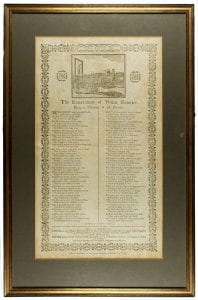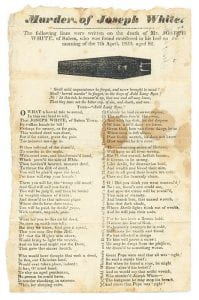‘Oh What a Horrid Tale to Sound’: The grisly world of broadside ballads
New acquisitions to the Baillieu Library Print Collection.
From podcasts, to YouTube channels, to Netflix documentaries, and feature films, the modern world loves to enjoy a tale of true crime. Combining the adrenaline rush of being spooked during a horror movie with telling reflections on the darkest side of human nature, it can be captivating to peek into tales of violence and woe. However, this fascination is far from exclusive to our contemporary society. In early modern Europe, particularly Britain, and later America, for a very small cost one could purchase a broadside ballad. Produced en-masse on extremely cheap paper, these single sheet missives were most often printed in two columns under a woodcut pictorial heading. They related recent and topical events in verse form, providing an affordable and entertaining resource to learn of current affairs [1.].
Broadside ballads were one form of what is known as ‘street literature’ and, as is still the case today, the more salacious the story the better it sold. Best-sellers often told of crimes and executions, and some editions are said to have sold over one and half million copies [2.]. Ballads such as these, telling of the heinous crime in question and how the accused met their end, were sometimes known as ‘good-nights’, in reference to all those involved who went into their eternal sleep. Certain popular tunes would be attached to the printed lyrics, the ‘hanging tune’ known as Fortune My Foe was often used for good-nights [3.].

Two such ballads have been recently acquired for the Baillieu Library’s collection, one being The Execution of Wild Robert, written in 1785 by Hannah More. Subtitled, ‘Being a Warning to all Parents’, the ‘graceless youth’ Wild Robert began with lesser sins of petty theft before turning to murder and ‘dyed his hands with blood’ as he killed a passing traveller for his money. More writes of how at the gallows, Robert’s mother comes forward to cry ‘“One moment hold! […] One kiss, my miserable child/ My Robert, once so dear!”’ to which he replies ‘ “Your’s is the fault I liv’d abhorred/ And unlamented die/ You gave me life, but with it gave/ What made that life a curse;/ My sins uncurb’d, my mind untaught,/ Soon grew my bad to worse”’. After Robert’s passionate speech as to how the lack of God and propriety in his childhood lead to his crimes and untimely death, the mother dies on the spot, ‘By conscience struck with death’, thus bringing the body count of the short tale to three. The ballad concludes with a moralising warning directed at parents to ‘Avoid the path she trod; And teach your sons in early years/ The fear and love of God’. More was an Evangelical Christian educator who used many forms of writing, including popular goodnight ballads, to preach her values and morals. While her work was philanthropic in its intention it was quite condemning of the lower classes, a prejudice evident in this ballad and her direct linking of Robert’s difficult upbringing and murderous crime [4.].

Some fifty years later in 1830 another ballad tells of a murder across the ocean in Salem, Massachusetts. The Murder of Joseph White is one of the most infamous crimes in 19th-century America; in the 1960s, law professor Walker Lewis commented that as a case it would be ‘credit to the imagination of any crime writer’ [5.]. Captain Joseph White was an 82-year-old wealthy shipowner and prominent citizen of Salem who met his end in his bedroom, via multiple stab wounds from a ‘dirk of death’. The ballad, to be sung to the tune of Auld Lang Syne, is written in part in the second person, spoken directly to the murderer himself. It admonishes, ‘You will be judg’d, and then be bound/ In weighty chains of wrath:/ And doom’d to that infernal place/ Where devils have their train,/ You will be paid, by devils’ grace,/ With torture, anguish, pain’.
As a rhetorical device, this use of second person puts the reader in the thick of the action, making them contemplate how it might feel to be the ‘poor feeble wretch’ who has committed such an atrocity and will suffer eternally for it. After a thorough and complex investigation, which revealed a conspiracy of stolen wills and iron chests of money, it was revealed that the hand who held the knife and bludgeon which ended White’s life belonged to a man named Richard Crowinshield [6.]. However, he was only a hired hand and the mastermind behind the plot was Frank Knapp, the brother of Joe Knapp Jr., who had married White’s grandniece Mary; the rich old man had disapproved of the marriage and disinherited her. Crowinshield committed suicide in jail and both the Knapp brothers met their demise at the end of a rope. Overall, it is indeed a ‘horrid tale to sound’ but evidently this did not dissuade the public from gobbling it up in the popular ballad form.
A vertically printed footnote in between the two columns of text reads ‘Sold Wholesale and Retail, owner of Merchant’s Row & Market Square, Boston’; the tale was grisly and shocking enough to warrant a printing in a nearby major city.
Despite the large quantities in which the broadside ballads were printed, the ephemeral nature of their purpose and extremely cheap quality of paper leave a comparatively small amount in existence today. While being neither high-end works of art nor produced with any thoughts of perpetuity, items such as these ballads offer a glimpse into how everyday folks of the past may have perceived the events of their time. The moralising lyrics and voyeuristic focus on the gory details of the crimes suggest a similar experience to the modern popularity of true crime stories. While there is a thrill in dipping one’s toe into murderous escapades, it is best to leave it at that, on the comfortably removed and neatly rhymed side of the ultimate sin. After all, after the scandal had blown away into yesterday’s news and the ballads are no longer sung, who would wish to consort with the Devils down below, when by the neck till death they have hung?
Adelaide Greig
Print Room Intern
References and further reading
[1.] Harris, Michael. ‘Printed Ephemera’ in The Oxford Companion to the Book, eds. Michael F. Suarez and H. R. Woudhuysen. Oxford: Oxford University Press, 2010.
[2.] Perkins, Maureen. ‘Street Literature’ in The Oxford Companion to the Romantic Age, eds. Iain McCalman and Jon Mee. Oxford: Oxford University Press, 2009.
[3.] Clark, Sandra. Women and Crime in the Street Literature of Early Modern England. New York: Palgrave Macmillan, 2003.
[4.] Scheuermann, Mona. In Praise of Poverty: Hannah More Counters Thomas Pain and the Radical Threat. Lexington, KY: The University Press of Kentucky, 2002., p. 136.
[5.] Lewis, Walker. ‘The Murder of Captain Joseph White, Salem, Massachusetts, 1830’, American Bar Association Journal, Vol. 54, No. 5 (1968). pp. 460-466.
[6.] Wagner, E. J. ‘A Murder in Salem. Smithsonian Magazine Online, 2010.
Leave a Reply